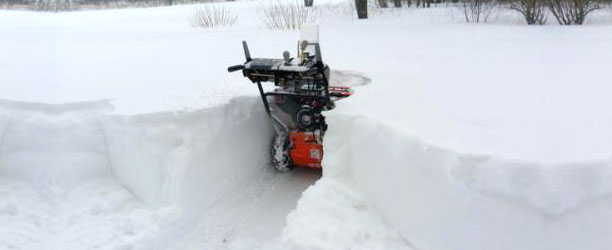
We’re not ready for it either, but since we can’t escape it. Here’s some Snow Blower Safety Tips…
Snow blowers are useful, but according to the U.S. Product Consumer Safety Commission, more than 4,000 people visit the emergency room every year due to snow blower injuries. Here’s how you can achieve snow blower safety.

Never Use Your Bare Hands
The most common injury associated with snow blowers involves damage to the fingers and hands due to people trying to unclog the machine with their bare hands. This should be avoided at all times because the revolving parts of the impeller blades can cause serious cuts and even amputation.
If the machine clogs, the first step should be to turn it off and disengage the clutch. Give at least 5 minutes for the blades to stop revolving, and use a tool such as a stick or the handle of a broom to unclog the auger or discharge chute.
Wear Safe Clothing
Avoid loose hanging clothes such as scarves, jewelry or baggy pants and jackets. The aim is to prevent any items of your clothing from getting stuck in the rotating parts of the machine.
You should also wear sturdy footwear that is firm and maintains a good amount of traction. Exercise extra caution when clearing surfaces that are normally slippery.
Be Careful with The Snow You Blow
Caution should be exercised when directing the discharge chute. Keep the chute out of the path of people passing by and other delicate areas. There is always a risk of hard objects being trapped in the snow blower and being discharged with a lot of force from the chute, causing damage to other surfaces upon impact.
Keeping children and pets away when clearing the snow is also an important part of snow blower safety.
Earplugs Are Important
The noise pollution from snow blowers can be harmful to your hearing. You should, therefore, wear earplugs anytime you’re out clearing the snow. Gas-powered snow blowers are particularly noisy, so extra caution should be exercised.
Remember About Electrical Safety
Electric models of snow blowers should be used with outdoor extension cords and outlets that are properly grounded. This reduces the risks of short circuits and tripping breakers. The power cord should also be kept away from the path of the snow blower.
Prevent Clogging
Before clearing a particular area, take steps towards preventing the snow blower from clogging. Remove debris such as newspapers, doormats, and wires. Work at a brisk pace to ensure that the blades are working faster and the snow has a less likelihood of sticking.
Clearing clutter as often as possible, and before the snow gets too deep, is also critical towards snow blower safety.
Wait for Fair Weather
The snow blower should only be operated when there are good light and visibility. Operating the machine in the dark or when it is raining/snowing can lead to risks such as slippery conditions, clogging of the machine, or reduced visibility of oncoming objects.
Categories: Blog
